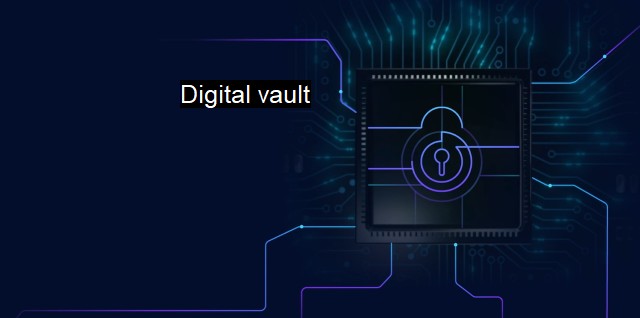What is Digital vault?
Understanding Digital Vaults: The Key to Protecting Sensitive Information in the Modern Cybersecurity Landscape
A digital vault refers to a secured online storage space where businesses and individuals store and manage their sensitive digital resources. This virtual safe offers a high level of security for documents and data, preventing unauthorized access through the application of advanced cybersecurity techniques such as multi-factor authentication, state-of-the-art encryption, intrusion detection systems, and biometric identification.Firstly, encryption is a principal element of a digital vault. It involves translating the sensitive data into a coded format, known as cipher text, which is incomprehensible to anyone trying to gain unauthorized access. This data can only become legible if decrypted by someone with the appropriate encryption key. This means that even if a cyber thief breaches a digital vault, they find meaningless data unless they can also break the encryption.
Intrusion detection systems are also employed by digital vaults as a proactive defense mechanism. They monitor the system, identifying any malicious activities that could be potential cyber threats. If detected, these systems generate alerts, prompting immediate action from those responsible for system security. Any suspicious behavior is documented and reported, and if deemed a serious threat, the detection system can implement measures to neutralize or eliminate the threat.
Multi-factor authentication adds an extra layer of security, involving multiple steps to verify the identity of users attempting to access the vault. Rather than just relying on a username and password, which can easily be compromised, multi-factor authentication requires additional information. This information could be a combination of something the user knows (like a password), something they have (like a physically-owned device), and something they are (like a biometric print). It makes hacking the vault incredibly difficult, as a cybercriminal would need to gain access to all authentication factors.
Biometrics, such as facial recognition, fingerprint scanning, and iris scanning are utilized in the most secure digital vaults. Since these features are unique to individuals, the use of biometrics ensures that only authorized personnel can gain access to the vault. It also eliminates the risk associated with lost, stolen, or easily guessed passwords that often provide an entryway to cyber intruders.
Digital vaults can also integrate antivirus programs that regularly scan files stored within the vault for any viruses and malware. Antivirus systems detect and clear out any harmful software that has managed to infiltrate the vault, further ensuring the integrity and safety of the stored information.
In the current digital era, the significance of digital vaults cannot be overstated. Businesses handle a large amount of sensitive information including intellectual property, financial information, employee records, and customer data. Losing this information or having it stolen or damaged could not only result in huge financial losses but also damage the reputation of the company. Digital vaults serve as impenetrable fortresses that offer premium protection for this sensitive data.
Likewise, individuals have an increasing need to protect their personal details like banking information, identification records, medical data, and more, given the growing rate of cybercrimes. This protection is provided by digital vaults, which privileged individuals access in order to keep their confidential information safely stored away.
a digital vault is an essential resource in the realm of cybersecurity. It operates by accurately authenticating user identities, employing intricate encryption to store data, preemptively identifying and combating cyber threats, and providing superior antivirus protection. The rise of cyber threats and data breaches reiterate the importance of applying state-of-the-art security measures, like digital vaults, to protect sensitive data. As digital threats become progressively prevalent and sophisticated, the integrity of digital vaults will establish trust in digital storage and online platforms while serving as an irreplaceable tool for safeguarding vital data.

Digital vault FAQs
What is a digital vault?
A digital vault is a secure, encrypted storage system designed to protect digital assets such as passwords, sensitive documents, and other confidential information from cyber attacks. It is like a virtual safe for your digital information.How does a digital vault differ from an antivirus software?
Antivirus software is designed to protect your computer from malware and viruses, while a digital vault is a secure storage system where you can store confidential information in an encrypted and password-protected environment. Antivirus software protects your computer from external threats, while a digital vault protects your sensitive information from both external and internal threats.How secure is a digital vault?
A digital vault is highly secure if it is designed and implemented properly. The security of a digital vault depends on the strength of the encryption algorithm used, the strength of the password, and the strength of the access control mechanism. It is important to choose a reputable provider that follows industry best practices for security and regularly updates their software to address new threats.What kind of information can be stored in a digital vault?
A digital vault can store any type of digital information that you want to keep confidential and secure, including passwords, personal identification information, financial information, legal documents, and other sensitive data. You can also store backups of files and documents in your digital vault to protect them from data loss.| | A | | | B | | | C | | | D | | | E | | | F | | | G | | | H | | | I | | | J | | | K | | | L | | | M | |
| | N | | | O | | | P | | | Q | | | R | | | S | | | T | | | U | | | V | | | W | | | X | | | Y | | | Z | |
| | 1 | | | 2 | | | 3 | | | 4 | | | 7 | | | 8 | | |||||||